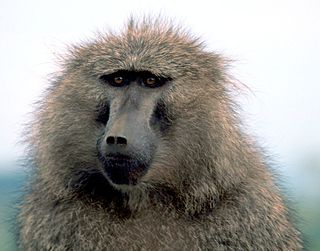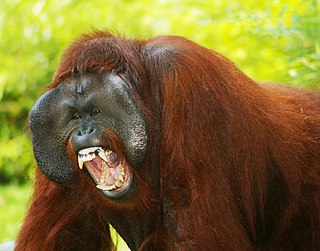Related Research Articles

The chimpanzee, also known as simply the chimp, is a species of great ape native to the forests and savannahs of tropical Africa. It has four confirmed subspecies and a fifth proposed one. When its close relative the bonobo was more commonly known as the pygmy chimpanzee, this species was often called the common chimpanzee or the robust chimpanzee. The chimpanzee and the bonobo are the only species in the genus Pan. Evidence from fossils and DNA sequencing shows that Pan is a sister taxon to the human lineage and is humans' closest living relative. The chimpanzee is covered in coarse black hair, but has a bare face, fingers, toes, palms of the hands, and soles of the feet. It is larger and more robust than the bonobo, weighing 40–70 kg (88–154 lb) for males and 27–50 kg (60–110 lb) for females and standing 150 cm.

Homininae, also called "African hominids" or "African apes", is a subfamily of Hominidae. It includes two tribes, with their extant as well as extinct species: 1) the tribe Hominini ―and 2) the tribe Gorillini (gorillas). Alternatively, the genus Pan is sometimes considered to belong to its own third tribe, Panini. Homininae comprises all hominids that arose after orangutans split from the line of great apes. The Homininae cladogram has three main branches, which lead to gorillas, and to humans and chimpanzees via the tribe Hominini and subtribes Hominina and Panina. There are two living species of Panina and two living species of gorillas, but only one extant human species. Traces of extinct Homo species, including Homo floresiensis have been found with dates as recent as 40,000 years ago. Organisms in this subfamily are described as hominine or hominines.

The genus Pan consists of two extant species: the chimpanzee and the bonobo. Taxonomically, these two ape species are collectively termed panins. The two species were formerly collectively called "chimpanzees" or "chimps"; if bonobos were recognized as a separate group at all, they were referred to as "pygmy" or "gracile chimpanzees". Together with humans, gorillas, and orangutans they are part of the family Hominidae. Native to sub-Saharan Africa, chimpanzees and bonobos are currently both found in the Congo jungle, while only the chimpanzee is also found further north in West Africa. Both species are listed as endangered on the IUCN Red List of Threatened Species, and in 2017 the Convention on Migratory Species selected the chimpanzee for special protection.

Primatology is the scientific study of primates. It is a diverse discipline at the boundary between mammalogy and anthropology, and researchers can be found in academic departments of anatomy, anthropology, biology, medicine, psychology, veterinary sciences and zoology, as well as in animal sanctuaries, biomedical research facilities, museums and zoos. Primatologists study both living and extinct primates in their natural habitats and in laboratories by conducting field studies and experiments in order to understand aspects of their evolution and behavior.

Research into great ape language has involved teaching chimpanzees, bonobos, gorillas and orangutans to communicate with humans and each other using sign language, physical tokens, lexigrams, and imitative human speech. Some primatologists argue that the use of these communication methods indicate primate "language" ability, though this depends on one's definition of language.

Kinji Imanishi was a Japanese ecologist and anthropologist. He was the founder of Kyoto University's Primate Research Institute and, together with Junichiro Itani, is considered one of the founders of Japanese primatology.
The Primate Research Institute, Kyoto University is a Japanese research center for the study of primates. It was founded in 1967 by primatologists Kinji Imanishi and Junichiro Itani. The institute works toward understanding the biological, behavioral and socioecological aspects of primates, and the origin and evolution of humans. The institute is located in the city of Inuyama, Aichi Prefecture, which is about 150 km east of the main campus of Kyoto University. Through the Division of Biological Sciences of the Graduate School of Science of Kyoto University, the institute offers graduate programs leading to the Master of Science and Doctorate of Science degrees in the field of primatological science. Since 2013, the director of the institute is botanist Hirohisa Hirai.

Tetsuro Matsuzawa is a primatologist who was a past director of the Primate Research Institute of Kyoto University. He graduated from Kyoto University with a B.A. degree in 1974, a Psy.M. degree in 1976 and a Ph.D. degree in Science in 1989.
Ayumu is a chimpanzee currently living at the Primate Research Institute of Kyoto University. He is the son of chimpanzee Ai and has been a participant since infancy in the Ai Project, an ongoing research effort aimed at understanding chimpanzee cognition. As part of the Ai Project, Ayumu participated in a series of short-term memory tasks, such as to remember the sequential order of numbers displaying on a touch-sensitive computer screen. His performance in the tasks was superior to that of comparably trained university students, leading to a possible conclusion that young chimpanzees have better working memory than adult humans, although this has been disputed.
Primate cognition is the study of the intellectual and behavioral skills of non-human primates, particularly in the fields of psychology, behavioral biology, primatology, and anthropology.

The Delboeuf illusion is an optical illusion of relative size perception: In the best-known version of the illusion, two discs of identical size have been placed near to each other and one is surrounded by a ring; the surrounded disc then appears larger than the non-surrounded disc if the ring is close, while appearing smaller than the non-surrounded disc if the ring is distant. A 2005 study suggests it is caused by the same visual processes that cause the Ebbinghaus illusion.
Imitative learning is a type of social learning whereby new behaviors are acquired via imitation. Imitation aids in communication, social interaction, and the ability to modulate one's emotions to account for the emotions of others, and is "essential for healthy sensorimotor development and social functioning". The ability to match one's actions to those observed in others occurs in humans and animals; imitative learning plays an important role in humans in cultural development. Imitative learning is different from observational learning in that it requires a duplication of the behaviour exhibited by the model, whereas observational learning can occur when the learner observes an unwanted behaviour and its subsequent consequences and as a result learns to avoid that behaviour.
Number sense in animals is the ability of creatures to represent and discriminate quantities of relative sizes by number sense. It has been observed in various species, from fish to primates. Animals are believed to have an approximate number system, the same system for number representation demonstrated by humans, which is more precise for smaller quantities and less so for larger values. An exact representation of numbers higher than three has not been attested in wild animals, but can be demonstrated after a period of training in captive animals.
Theory of mind in animals is an extension to non-human animals of the philosophical and psychological concept of theory of mind (ToM), sometimes known as mentalisation or mind-reading. It involves an inquiry into whether non-human animals have the ability to attribute mental states to themselves and others, including recognition that others have mental states that are different from their own. To investigate this issue experimentally, researchers place non-human animals in situations where their resulting behavior can be interpreted as supporting ToM or not.

Pointing is a gesture specifying a direction from a person's body, usually indicating a location, person, event, thing or idea. It typically is formed by extending the arm, hand, and index finger, although it may be functionally similar to other hand gestures. Types of pointing may be subdivided according to the intention of the person, as well as by the linguistic function it serves.
The evolution of cognition is the process by which life on Earth has gone from organisms with little to no cognitive function to a greatly varying display of cognitive function that we see in organisms today. Animal cognition is largely studied by observing behavior, which makes studying extinct species difficult. The definition of cognition varies by discipline; psychologists tend define cognition by human behaviors, while ethologists have widely varying definitions. Ethological definitions of cognition range from only considering cognition in animals to be behaviors exhibited in humans, while others consider anything action involving a nervous system to be cognitive.
The cognitive tradeoff hypothesis argues that in the cognitive evolution of humans, there was an evolutionary tradeoff between short-term working memory and complex language skills. Specifically, early hominids sacrificed the robust working memory seen in chimpanzees for more complex representations and hierarchical organization used in language. The theory was first brought forth by Japanese primatologist Tetsuro Matsuzawa, a former director of the Primate Research Institute of Kyoto University (KUPRI).
Dora Biro is a behavioral biologist and the Beverly Petterson Bishop and Charles W. Bishop Professor, Brain and Cognitive Sciences at the University of Rochester. She was previously a Professor of Animal Behaviour at the University of Oxford. and a visiting professor in the Primate Research Institute of Kyoto University in Japan. Biro studies social behavior, problem solving, and learning in birds and primates.
Primate archaeology is a field of research established in 2008 that combines research interests and foci from primatology and archaeology. The main aim of primate archaeology is to study behavior of extant and extinct primates and the associated material records. The discipline attempts to move beyond archaeology's anthropocentric perspective by placing the focus on both past and present primate tool use.
Simone Susanne Pika is a German ethologist and primatologist investigating the evolution and development of language, cognition and plasticity by focusing on distinct model systems such as corvids, great apes, monkeys and dolphins. Since 2017, she co-directs the Ozouga Chimpanzee Project, Loango National Park in Gabon. She is a full professor at the Institute of Cognitive Science, Osnabrück University, Germany.
References
- 1 2 3 4 5 Matsuzawa, Tetsuro (2003-12-01). "The Ai project: historical and ecological contexts". Animal Cognition. 6 (4): 199–211. doi:10.1007/s10071-003-0199-2. ISSN 1435-9448. PMID 14566577. S2CID 8928490.
- 1 2 3 4 Matsuzawa, Tetsuro (October 2009). "The chimpanzee mind: in search of the evolutionary roots of the human mind". Animal Cognition. 12 (S1): S1-9. doi:10.1007/s10071-009-0277-1. ISSN 1435-9448. PMID 19727864. S2CID 7028415.
- 1 2 "Ai | Chimpanzee Ai | Primate Research Institute, Kyoto University". langint.pri.kyoto-u.ac.jp. Retrieved 2020-10-24.
- ↑ "Thinking Like a Chimpanzee". Smithsonian Magazine. Retrieved 2020-10-24.
- ↑ Neal Webb, Sarah J.; Hau, Jann; Schapiro, Steven J. (January 2019). "Does group size matter? Captive chimpanzee ( Pan troglodytes ) behavior as a function of group size and composition". American Journal of Primatology. 81 (1): e22947. doi:10.1002/ajp.22947. PMC 6472487 . PMID 30620093.
- 1 2 3 4 Matsuzawa, Tetsuro (April 2017). "The 40th anniversary of the Ai Project: the commemorative gift is a silk scarf painted by Ai the chimpanzee". Primates. 58 (2): 261–265. doi: 10.1007/s10329-017-0604-0 . ISSN 0032-8332. PMID 28293756. S2CID 3635041.